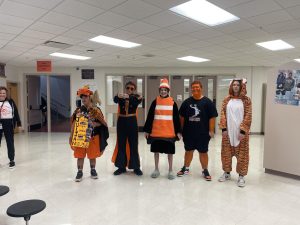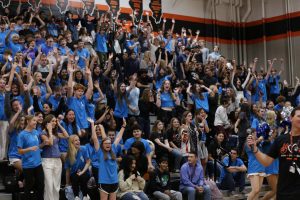STEM classes at East: Where have all the girls gone?
Students reflect on the the ratios they see at school
Students relaxing at the end of an ICB II class. In many STEM classes at East, including math, chemistry, biology, physics, woods, autos, PLTW, and other courses, boys outnumber girls. Photo by Sophia Smallwood.
April 5, 2022
Have you ever looked around your AP Physics or AP Chem, AP Calc, Woods or Autos class and wondered: Where are all of the girls? We have, too, and have decided to begin a series of stories in the X-ray that focuses on girls in high-level STEM classes here at East and how some are working on improving the numbers,
Some female students at East choose to challenge themselves with a difficult science or math course, but at the same time, many others pass on the offer. Lyra Tiffin, a sophomore at East, is one female student who has a passion for science, math, and being challenged.
“In my science class, boys outnumber girls by over 2:1 and in my math class the ratio of boys to girls is 3:1,” Tiffin told us.
When asked why she believes there is an imbalance between girls and boys in her classes, she said, “It’s for a variety of reasons, but I think that part of it is that when girls aren’t initially good at science and math, there is no pressure for them to push themselves past that uncomfortableness because they aren’t expected to be good at it anyways. Therefore, fewer girls are encouraged to choose high level math and science classes.”
While a lot of students see the imbalance, others don’t seem to notice. We spoke to Coral Cotteleer, a senior at East, who is currently taking AP Chemistry.
“I do not see a lack of representation occurring. I think there’s equal interest in taking high-level AP courses,” Cotteleer said.
To gain more insight on the matter, we spoke with Jillian Plochocki. She’s the executive director of Proton Collaborative Group, an organization that sponsors radiation oncology clinical trials in 23 cancer centers across the US and Europe. Proton Collaborative Group focuses on proton therapy, a specific kind of radiation therapy, to treat cancer patients. The company currently has 8 clinical trials in their profile that demonstrate the effectiveness of this type of therapy in both the long term and short term, for 30 different types of cancer. The goal of the group is to make cancer treatment through proton therapy more efficient for patients, while maintaining the least amount of side effects that come with it.
“Women are absolutely underrepresented in STEM careers, although I do see a more even distribution of males and females in radiation oncology compared to other STEM-related careers. I think this is due to several reasons…a lack of female mentorship during middle and high school, a lack of understanding on how STEM-related careers positively impact the community and contribute to meaningful work, and continued gender biases and stereotypes on women’s competency in these fields,” Plochocki told us.
“Women are still in a position of having to prove themselves in male dominated fields. We have to work harder and take on more responsibility with less pay to remain competitive and to be viewed as competent by our male counterparts,” she said.
When asked what she would tell young girls taking high-level math and science courses in high school, she had a few words to share.
“Every generation of women helps pave the way…the more we persevere the more we can positively impact how women are represented in these fields. These fields of work need our perspective, our creativity, and our presence at the table.”













